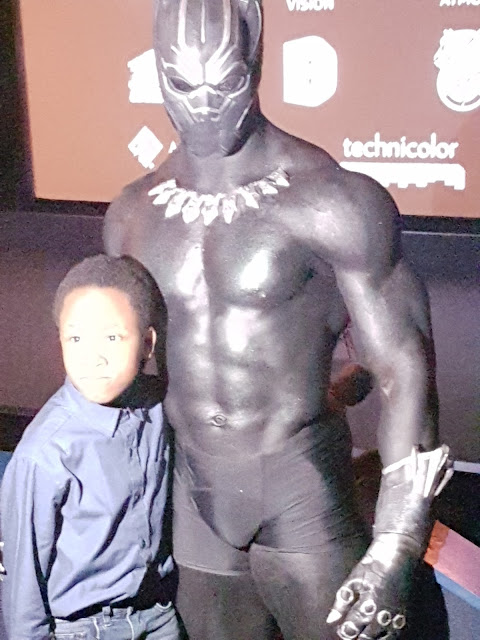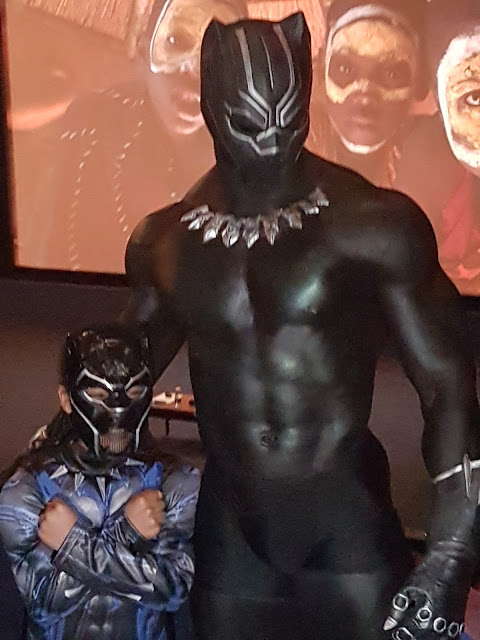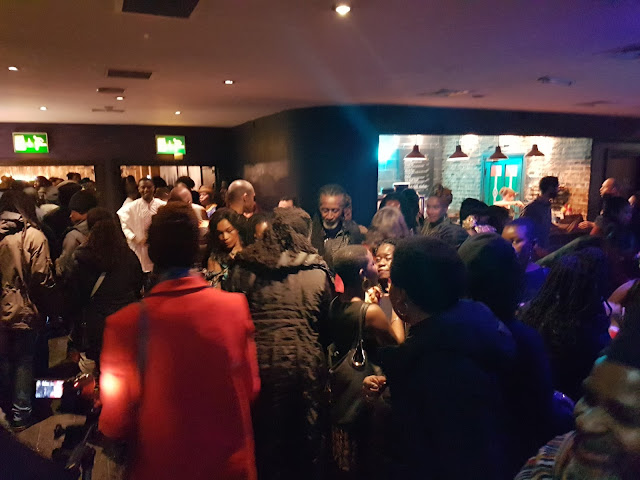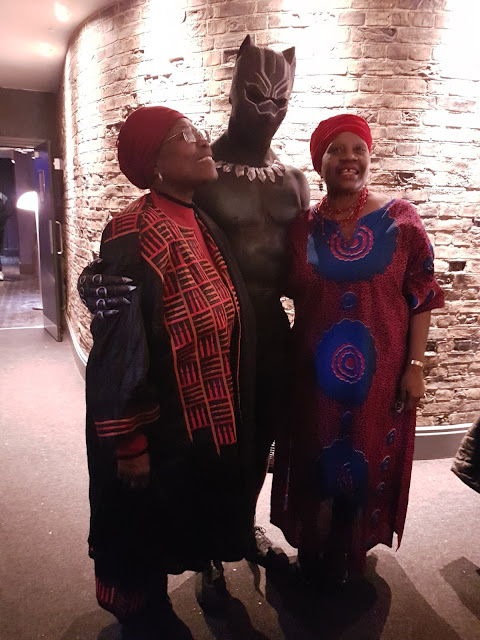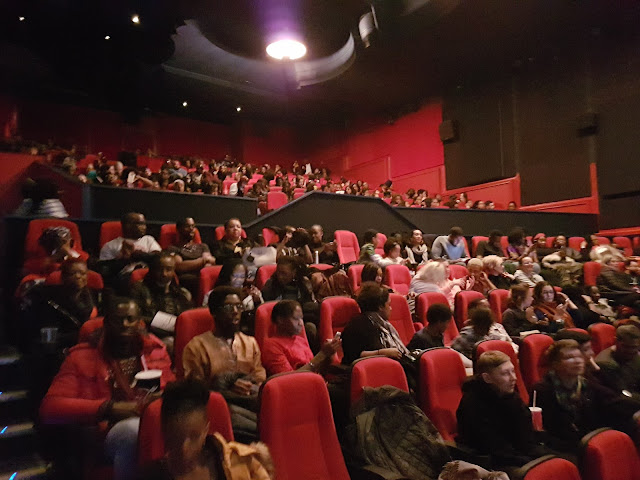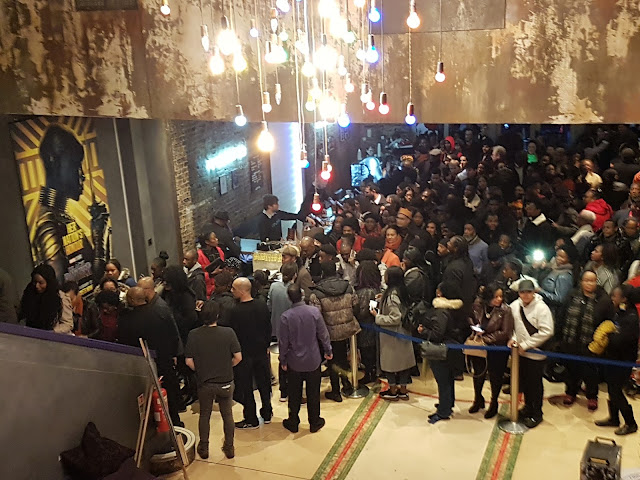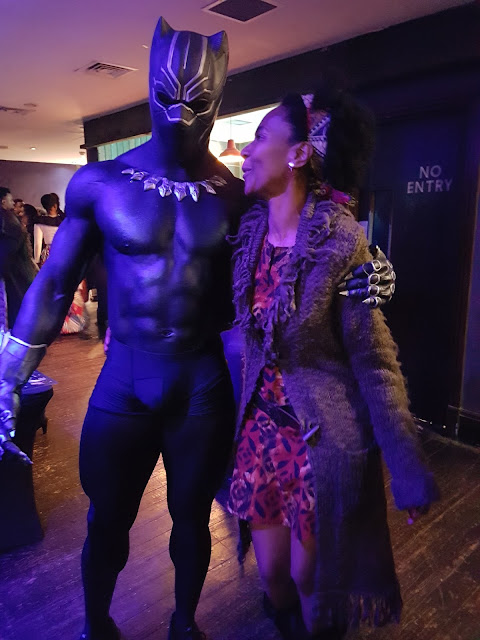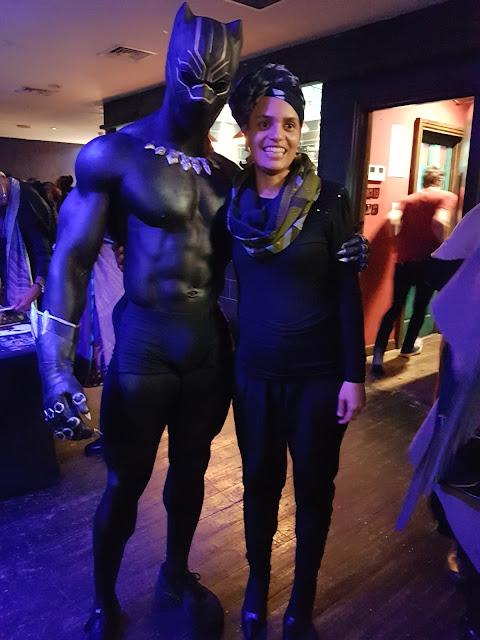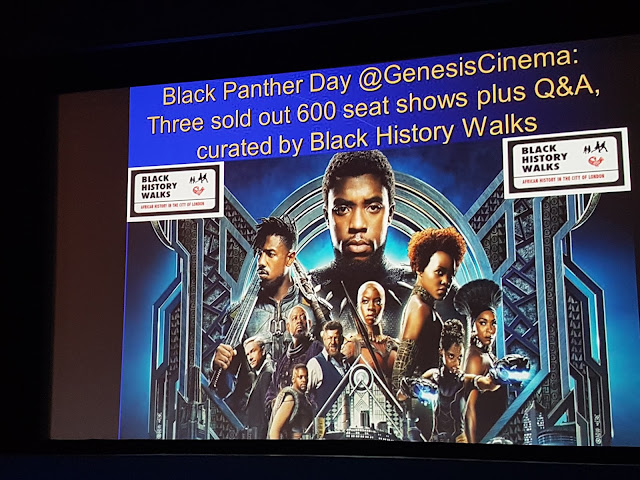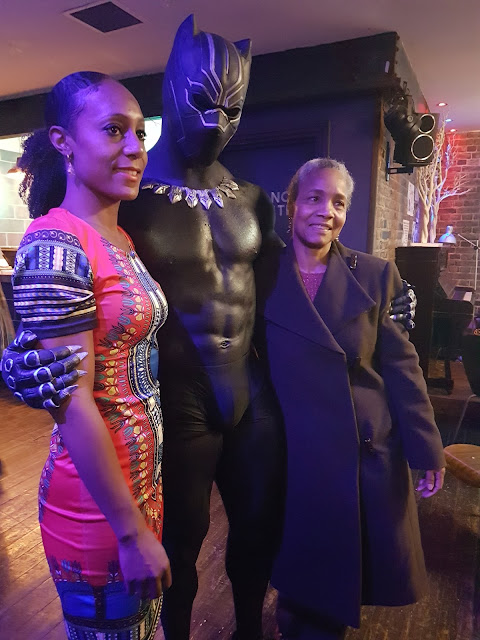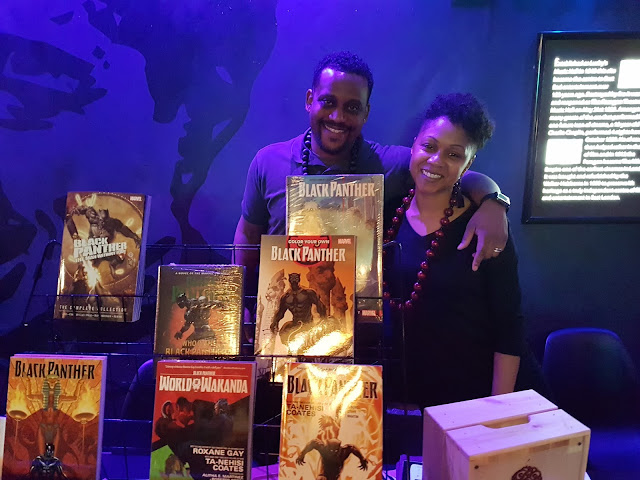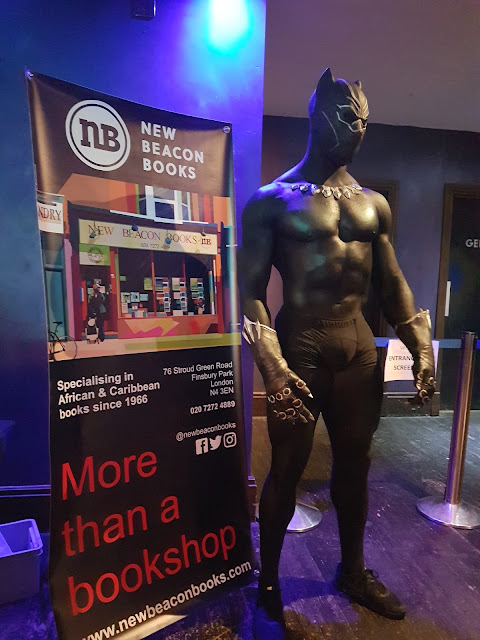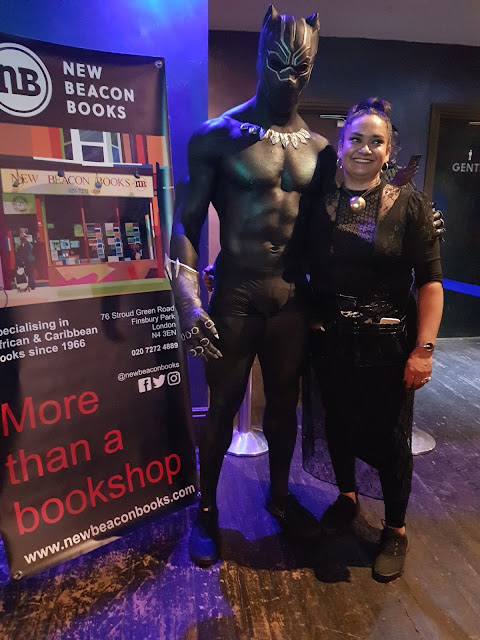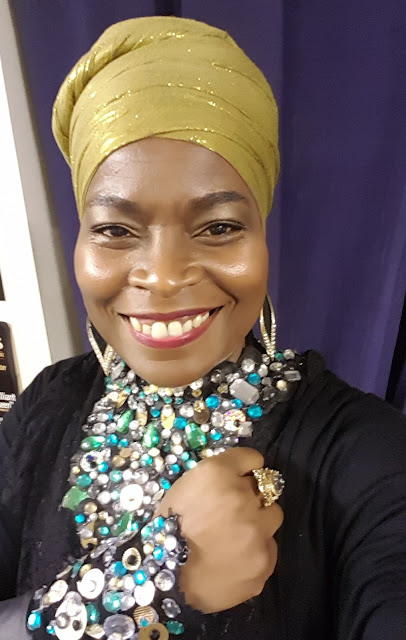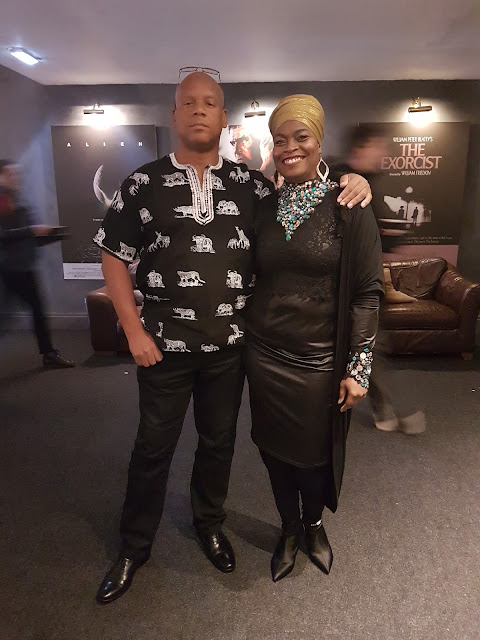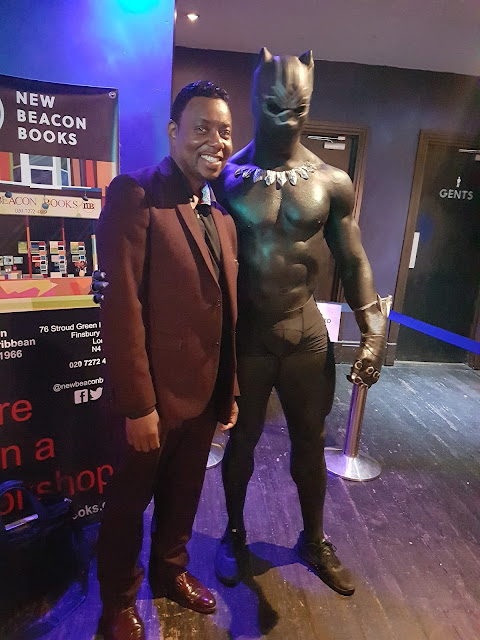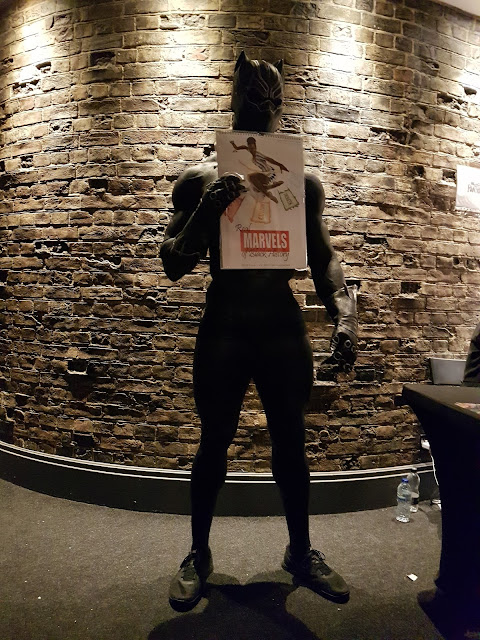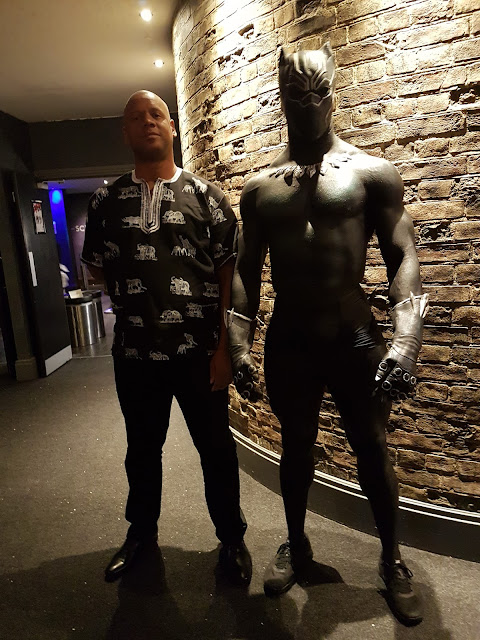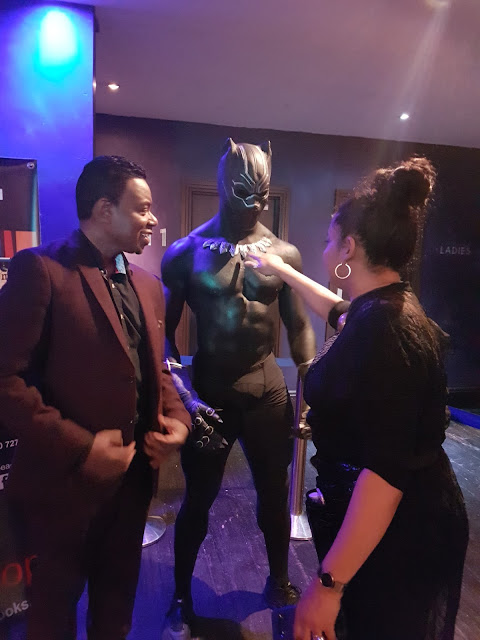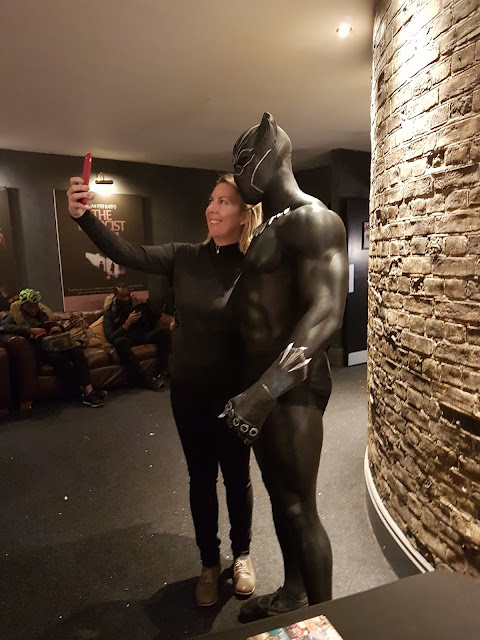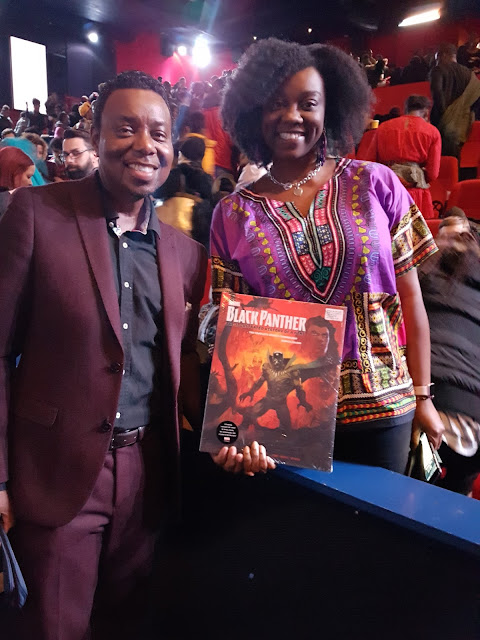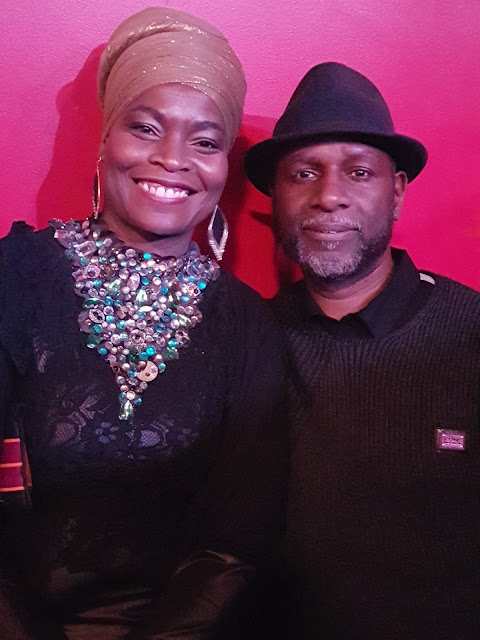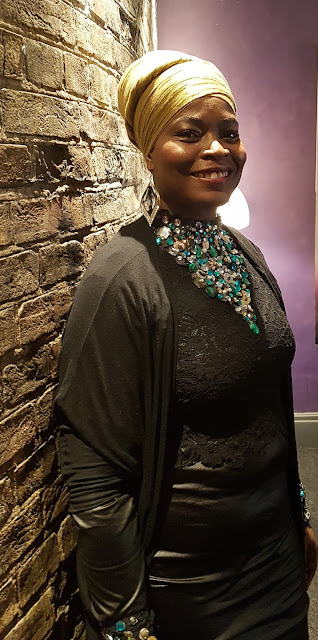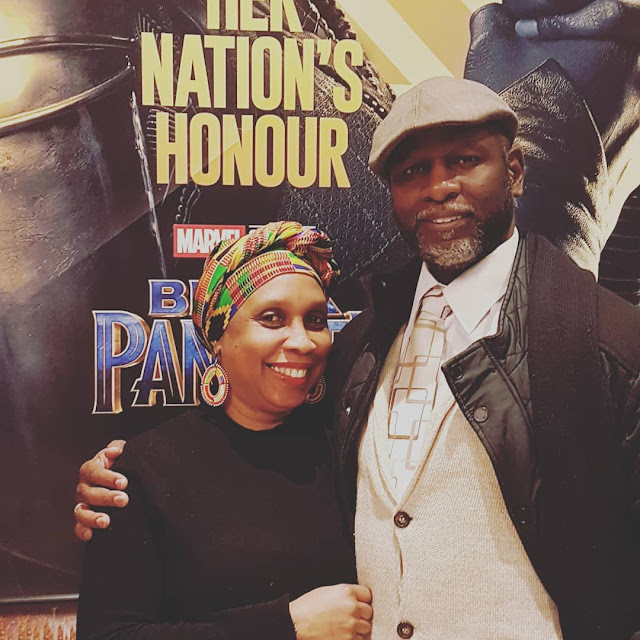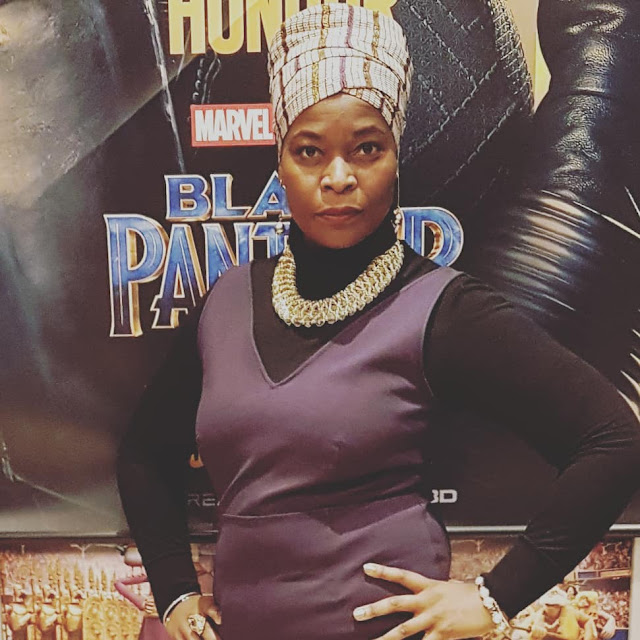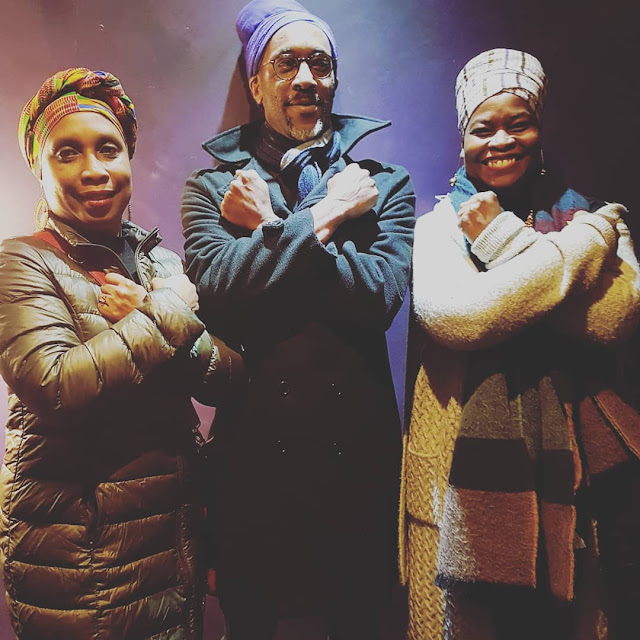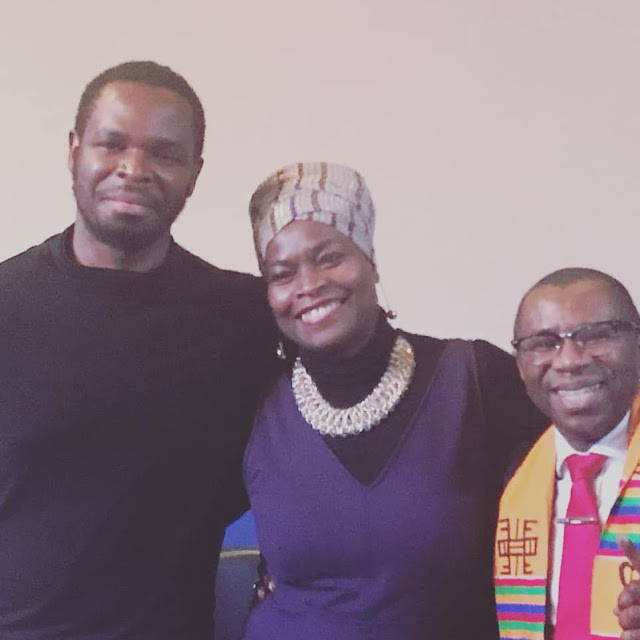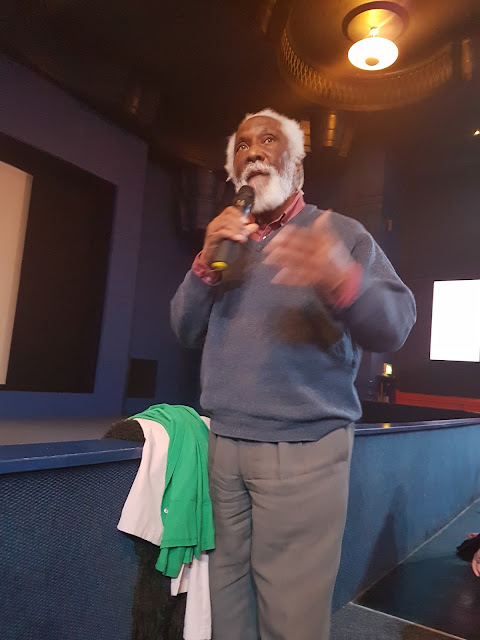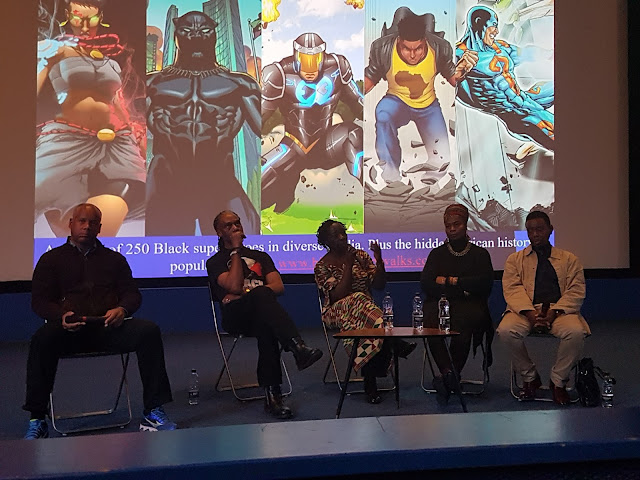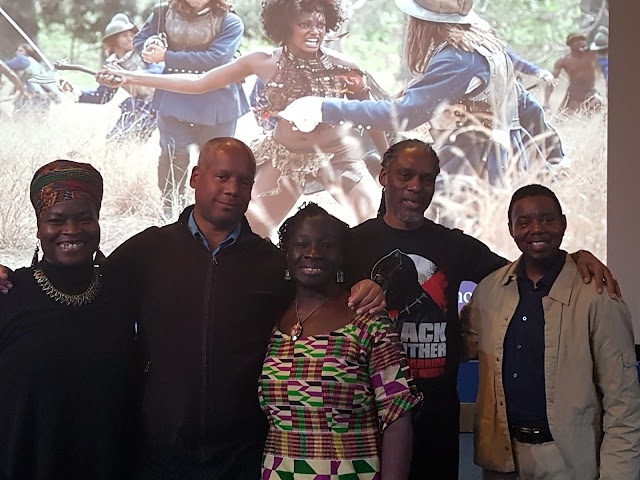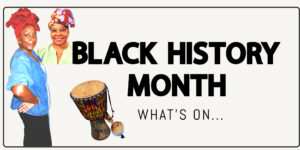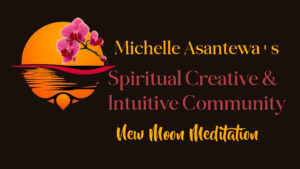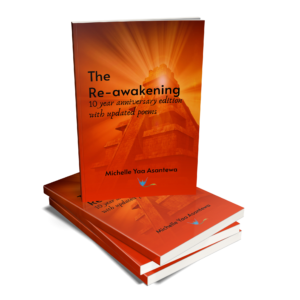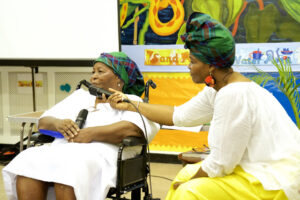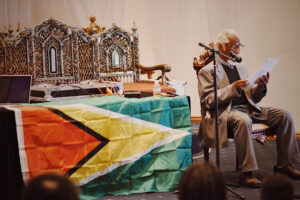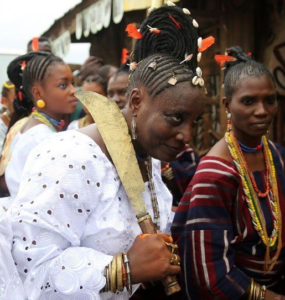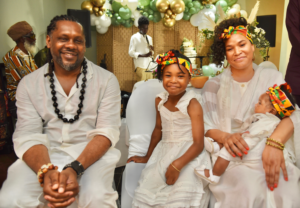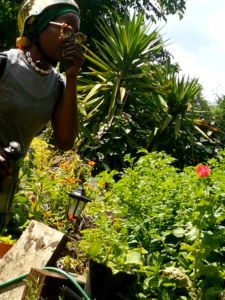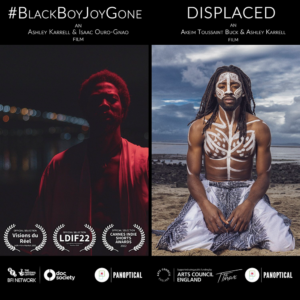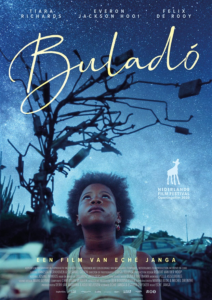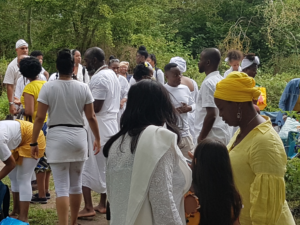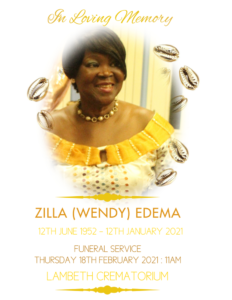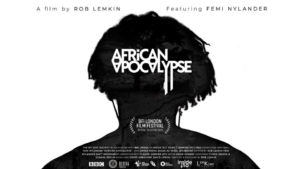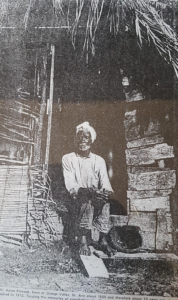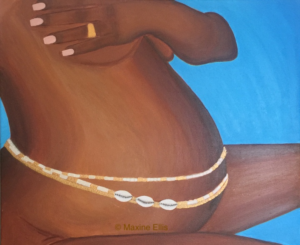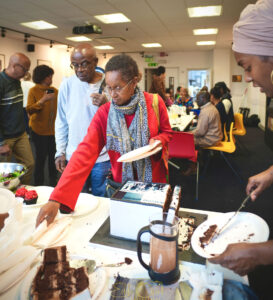
Disclaimer: Use of Copyrighted Images
The images used on this
blog and in our newsletters are sourced for educational purposes only.
These images are the property of their respective copyright holders and
are used under the principle of *fair use* to support commentary,
analysis, and discussion. We make no claim of ownership over any
copyrighted images and have taken all reasonable steps to attribute them
appropriately.
If you are the copyright owner of any image
featured here and believe it is being used improperly, please contact us
directly. We are committed to respecting intellectual property rights
and will take prompt action to resolve any concerns.
This content
is not intended for commercial use, and any reproduction or
distribution of the images without proper authorization may violate
copyright laws.
The day Black Panther SOLD OUT 3 screenings and made history at Genesis Cinema East in London
-
 By
Dr Michelle Yaa Asantewa
By
Dr Michelle Yaa Asantewa
- 14 minutes
- Article
Share
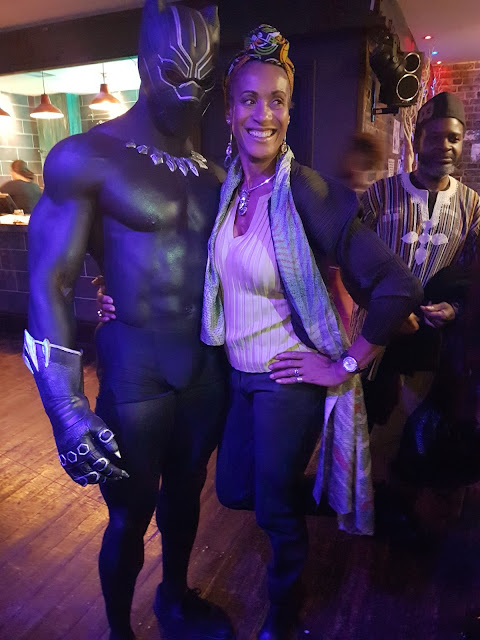
Though it’s a while after the historic event, this post is recorded belatedly for posterity.
Tony Warner of Black History Walks invited me back in November or December last year to take part in the Q&A for the well-anticipated release of the Black Panther movie. I was apprehensive because I’m not a comic bookie – or even Marvel fan – though I’d seen the various MCU (Marvel Cinematic Universe) films – including the Avengers with the fabulous entry of Chadwick Boseman as Black Panther and the promise then of a stand-alone film with him in the role. I had also taught genre fiction briefly but the main premise for my participation was that I could speak to the elements of spirituality in the film. That initial invite was for one screening for a weekend showing and another was arranged for a weekday screening.
That first one sold out in a few days. Tony pressed – yes he had to press them – to organise a second screening. Tony knew how popular the film would be and wanted to ensure as many people get to see the film as possible. That second screening sold out within hours of being advertised. We’re talking 600 seater screens. By now, sniffing the loot and magnitude of the film the cinema pressed – yes they pressed Tony to organise a third screening. That too sold out within hours. I now have to do 3 Q&As on the same day! This was days after its general release – on Sunday 18th March. This 3 times watching, 3 times Q&A on the same day in itself was a record for me – and I’m sure Tony and Terry Jervis with whom we’d share the panel.
Africans take over the cinema
Since the premier a few days earlier it was clear something super special was out there. And Africans were ON IT. For the numbers of critiques (some truly vitriolic, I must say) of the film by some worthy commentators, there were thousands more that were hyping positively about it. Brothers and sisters were shedding tears for seeing what was being described as ‘an experience’ rather than a film. Some were ecstatic to see a predominantly African cast, they hadn’t seen that before – not like this, not in such a positive way. Hollywood has given Africans slavery, nothing before or progressive and positive after, as our history and experience on film. Representationally, this was different – and Africans needed it. An instant movement and developed in cinematic history – central to this was the cult of Wakanda, spurred by the shared images of Africans dressing up to do see the film.
On the 18th February, swarms of beautifully dressed African men, women and children turned up for the 3 screenings at Genesis. I had seen comments floating around about ‘how they going on like this, wearing dashiki’s and so on just for a movie.’ But the movement was in swing – most people went for it. As did I. My best friend (Kathy Nanena), a makeup artist, who is also handy with a sewing machine to create costumes made a glitzy necklacey thing for me with matching cuff braces. She also body painted her son’s friend (Agui Mansilla), who does bodybuilding to play Black Panther. She had no idea about the Black Panther film but observed Lupita N’yongo and the other sisters from the film and how glam they looked – she wanted to glam me up too for the Q&A. Agui had asked me what he would do on the day – as it was my suggestion he came as a kind of ‘mascot.’ I said just ‘be.’ As soon as he entered the cinema – he was mobbed. I can’t print some of the things women whispered in his ear as they posed for pictures with him. But I shall never forget the glee on those young children’s faces as they waited and then posed for their pictures of a superhero that looked like them.
The cinema was inundated with Africans. By their admission, they had never had so many Africans through their doors. In fact, they had never had such large numbers ever for a single film in their entire history. One of the managers, who was there for the 3 successive screening told me – ‘it was the best event they had ever had there.’ She called it ‘event’ because that’s what it was.
Renaldo and Vanessa La Rose of New Beacon Books
Agui Mansilla (‘Black Panther’) and Kathy Nanena (Makeup artist)
Some thoughts on the film
I had been doing Guyana/Caribbean style shouts at the screen during the film. I’d also observed audience responses to the scenes. Most responded to was – ‘don’t scare me like that coloniser’ a wonderfully delivered line by Letitia Wright (Shuri); the gorilla blowing at the ‘coloniser’ (CIA agent! Martin Freeman/Ross) and then ‘you do not speak’ a line equally well delivered by Winston Duke, a scene which was superbly complemented when he laughs following the vegetarian joke – a natural, spontaneous laughter that they kept in.
Contrasting the light laughter stuff were those scenes with Erik Kilmonger (Michael B Jordan) where line after line it was impossible to regard him as an enemy (or supervillain). You can find ample discussions, critiques, essays on his supposed ‘revolutionary character’ being ‘killed’ in preference to the seeming UN/CIA ‘friend’ T’Challa (Boseman), so I’m not about to add/take away from those discussions because I think there is some measure of validity in each of them. What I don’t agree with is that the film fails as a revolutionary document BECAUSE of this! Not too many of us have experienced actual revolutions – yet we seem sure we know how writers should depict them through the propaganda tool that is Hollywood. I think much more interesting feats are notable from the film – not least that it has smashed sales records across the world within its first weekend of general release. It is now the ‘biggest moneymaker among superhero movies in the US.’ It has also reached so many Africans who can see themselves in the complex and dynamic ways we are. We are not opposites, but composites. We are in some ways reflected in the axis tilt when Kilmonger has won the thrown in combat with T’Chala – recall that scene?
It is impossible to despise Kilmonger and wish him dead (or hurt or some such one would anticipate for the film’s antagonist) because he speaks our thoughts and feelings. He is hurt, as we are hurt. He is angry as we are justifiably angry. He wants to see the sunset of his African homeland and resents the fact he has had to face the darkness of his trauma alone. We’ve yet to get the backstory about his mother and other family members in the US – otherwise, the character in this instance is not unlike Bigger Thomas as created by Richard Wright, about which James Baldwin had some interesting things to say in his essay ‘Many Thousands Gone.’ At least, we get one side of his family (the elite royals from whom he’d been estranged through no fault of his own), but what about his family, extended or otherwise in the US? What happened to him after his father was killed?
Film producer Terry Jervis with Agui Mansilla
Tony Warner with ‘Black Panther’/ Agui Mansilla
It’s difficult to align with T’Chala because, as Boseman said in one of the many interviews he has done since the release of the film, he, T’Chala ‘was born with a vibranium spoon in his mouth.’ We were struggling to properly ‘identify’ with him, given that privilege is not the experience of many Africans. We have to reconcile our issues with elites and royalty who hold power and can, therefore, decide to pursue the process that revolution is or choose to ‘reform’ which would give concessions that might be detrimental to African sovereignty. That said, I doubt Kilmonger is dead for real! There must be scope for him returning to the MCU sequences – with a backstory (the US family, for example); they’ve done this before in the MCU repertoire so it’s possible.
From a spiritual and gender perspective I felt it when he killed his sister-lover then through his spiritual and cultural ignorance killed the spiritual leader of Wakanda (Zuri/Forest Whitaker – even though Zuri violated the protocol and interrupted the fight sequence with T’Chala), then grabbed by her neck, Zuri’s successor (another sister) and flings her across the sacred sanctuary before ordering they burn the heart herb that is the strength of the Black Panther. Before his final battle with T’Chala Kilmonger is also engaged in battles with other sisters – the Dora Milaje force, he kills one of those, then is about to take on Shuri and Nakia (Lupita N’Yongo). In other words, a lot of the character’s fight sequences were with sisters. This is not revolutionary. It’s an imbalance that perhaps speaks in some part to his rage, and which adds to the quality and complexity of the character, and therefore scope for his return.
The writing
I congratulate Ryan Coogler and Robert Cole for accomplishing a tale that enables a wide discussion about the experience of Africans. They did so within the confines of writing a superhero movie – seemingly for entertainment (there was ample of this but layers of stuff we could unpick that speak to African experiences). Coogler’s influence in getting the calibre of actors and actresses to feature in the film and to give each a chance to assume future opportunities shows that he is a writer/director of a special stature. A few years ago my partner and I went to see Coogler’s first film Fruitvale Station. The sales clerk asked us if we wanted VIP seats – we thought – ok. We paid for same, only to enter the theatre and realise we were the ONLY PEOPLE watching the film. And now – well the brother gone clear!
The feel-good factor of the film outweighed some of the complex issues. The women rocked their roles superbly. I saw the essence of the Orisa Oya in Okoye’s depiction of the general of the Dora Milaje. Certainly, the writers seem to set out on a mission to empower African women through every feature – bar the role of ‘Queen’ or one who sits on the throne. The nice touch of comedy, however, during the first battle for the thrown indicated Shuri’s pose that she could take up the throne and become Black Panther, as she does in the comics.
The film was far too generous to the CIA agent – it was a humungous elephant, which I hope might be addressed more creatively in the sequel. There is no way that ‘character’ should have as much knowledge that he now has about Wakanda. He is super cuddly in the film, which doesn’t make sense – not even to disrupt the dominant narratives about the pernicious activities over decades committed by the CIA. He is the one who INFORMS us about Erik Kilmonger’s mercenary actions, which have included toppling governments. It’s classic double speak, deliberately upholding the imperialism of the US – they save the world. They don’t topple governments! If you have no idea about the machinations of US imperialism, you’ll run with the cuddly CIA character -just as we ran with the racist John Wayne who thrashed indigenous peoples for most of his acting career. Agent Ross might well grin at the end of the movie because he knows a lot about Wakanda now.
I thought the sequence when T’Chala returns to the ancestral realm to speak for the second time with his father was a little forced initially in terms of writing. The ancestor, King T’Chaka (Jon Kani) would hardly open his arms to welcome T’Chala to the ancestral realm when the kingdom of Wakanda is being overrun by an ‘outsider’ (Kilmonger). I know it was trying to set up the moment for T’Chala to admonish his father and realise his separation from father and become his own King, but the line weakened the power of the African ancestors. That said, it enabled Boseman to give his most austere performance in the film by calling out the ancestors for their oversights.
The Q&As
The Q&As were brief because we had to prepare each time for the next screening. Ateinda Ausarntu hosted the third as Tony had to leave to collect a Screen Nation Award for putting on Superhero movies for the past 15 years – nuff congratulations Tony! This last of the Q&As stands out because it reared the intense question about the connection between the ‘real black panthers’ and Hollywood’s demonisation of them – which it was being suggested was the reason for creating the accommodating T’Chala version. Because it was a real but heavy issue it took away from the veneer of pleasantries about the film, which was mostly highlighted in the first two sessions. I sensed the audience wilting as we were after the third time going through the film. I reconciled that it was necessary for the audience to be as aware about the wider issues, in any case, and so invest in now seeking to better understand the importance of the Black Panther to the Civil Rights movement. It is also not insignificant that the Panther symbol was developed by the Lowndes County Freedom Organisation (LCFO), which comprised members of the Student Non-Violent Coordinating Committee (SNCC – one of whose members were Stokely Carmichael/Kwame Ture) and local Africans of Lowndes County in 1965. Marvel’s Black Panther was created by Stan Lee and Jack Kirby some months after in 1966.
And the history matters. This was another important feat of the film, reminding us that Africans have to tell our stories by any means, lest others do – supposedly on our behalf – but from their squinted point of view and essentially perpetuate their capitalistic exploitation of us. This was ungraciously depicted in the film by Stan Lee’s cameo in the Casino scene in South Korea when he gathers Black Panther’s winnings after the fight breaks out with Ulysees Klaue (Andy Serkis).
There was another Q&A, which I both chaired and shared the Panel with Andrew Muhammad and Nosa Ibenidion on Thursday 23rd February. This discussion was upbeat, centering on the many African history images/references in the film, the fact (for filmmaker Nosa – check out his Rise of Orisa series) that it was possible to be young (as Coogler is) and make it a culturally representative film that is so successful. We also talked about the power of female representation – Andrew remarking that this was captured in the scene when the Dora Milaje general played by Dani Guirira steps in front of the rhino to defend M’Baku. It reminded him of Nana Yaa Asantewaa, Queen Mother of Ejisu taking up the battle against the British colonials during the 1900-01 Asante Wars. I thought that bit of history was captured, again by Danai Guirira when the CIA agent touches the Black Panther (during the interrogation scene with Klaue) – symbolising the ‘soul’ of the people, as the Asante Stool represented when the British ‘governor’ tried to wrest it from the Ashanti, causing the war in the first place. The numbers at this midweek screening was about 200, some people seeing the film for their second or third time. There was a sister who had created a fundraiser and had raised £1000 so that 200 young children (from Hackney) could go and see the film. She said some of them had never been to the cinema in their lives. This is the power of the film, it has mobilised people, young and elder in so many ways. It will contribute to shaping the way a new generation of young Africans see themselves and their futures. It has done so much for the Afro-futurist genre as a consequence – so that other such projects – especially independent ones will be given wider (we trust it to happen) exposure and support.
Panel on 23rd February, Noso Ibenidion, Michelle Asantewa and Andrew Muhammad
And because the Q&As were brief, Tony arranged for there to be one last screening with an hour-long Q&A so that we could get a longer discussion about the film. This was on Sunday 11th March. This panel was shared by Dr Ama Biney, Dr Lez Henry, Terry Jervis and myself again and Tony Warner chairing. As before Tony invited us to talk about our favourite scene and themes. Terry Jervis loved the incorporation of images that reflect African history, the last scene with T’Chala at the United Nations which he thought mirrored Emperor Haile Selassie’s speech to the United Nations in 1968. Whilst Dr Biney appreciated the visually stunning representation of Africans in the film, and the agency attributed to the women, she felt Erik Kilmonger was a revolutionary cut down like so many of our revolutionaries in the struggle against imperialism. Dr Lez Henry made some poignant comments about the relationship between African men and women, which the film was depicting positively and saw the film as an important cultural document that can be used as an educational resource. I agree with him.
I added, as before, that my favourite scenes and themes were the ones referencing African spirituality. When T’Chala goes into the ancestral realm to see his father, I appreciated the magical vibration of this scene – the silent power of the panther symbolic of the strength T’Chala has at his disposal, if he knows can learn how to harness it. The mirroring scene where T’Chala is fighting with Erik Kilmonger reflects the moment of facing one’s inner urges, those positive and negative things of which we are comprised. T’Chala is here facing himself – (he has to ascend to the crown/consciousness – which he cannot attain without struggle/fighting for it); Kilmonger has to overcome/contextualise his rage – if indeed he must die – he will join his ancestors (find freedom his way) where he will learn about himself, harness his power more effectively in readiness for a return where he has ‘respect for life’ and the spiritual aspects of his ancestral traditions. If he is to understand himself fully (and recognise his ‘brokenness’) he must respect balance – one of the basic African philosophic principles -that balance of the feminine and masculine divine we find when we look closely at ancient African spiritual systems. This 5th Q&A provided the audience with a longer time to contemplate the qualities of the films. Whilst the panel didn’t always agree, that made for an intriguing debate I hope was appreciated for what it was. For this, we must big up Tony Warner, because he had once more to convince the cinema that this 5 screening, hosted by Black History Walks was necessary. There were at least 400 people at the cinema for that one – adding to the record.
Eric Huntley at the Q&A on 11th March
Panel on 11th March, with Tony Warner, Dr Ama Biney, Dr Lez Henry and Terry Jervis
Final word
It’s interesting that Tony had to convince the cinema to screen the Black Panther with another Q&A given that it was breaking their own records. What does that say about where we are as Africans in this country when it comes to total ownership of spaces through which we can put on screenings and other culturally empowering events? Because Black Panther was smashing records in its first weekend some people were talking about investing in Disney! It would make better sense, in my humble sense of financial intelligence, to invest in our directors and writers and their production companies and create our own industries around this, as opposed to propping up Disney if we have the means to invest. Disney couldn’t have made the dough it did without the creative output of Ryan Coogler and Robert Cole in this instance. We need our own cinema complexes, let alone buildings for our own projects/events so we don’t have to plead with others for space to do our thing. Imagine we have to do this even when it has proven its economic viability – speaking of Black Panther. It’ll take only 10 million or so pounds to get there, but we’ve shown that we have the means when it matters to smash records and disrupt expectations. Maybe that’s an outreach idea for T’Chala to consider too!

